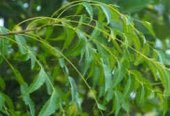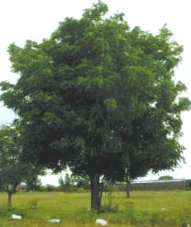|
The Many Wonders of NeemNeem (Azadirachta Indica) was first recognized for its healing properties by the inhabitants of India and Southeast Asia as early as 4000 B.C. It is still referred to as "the village pharmacy" in its native India, and is one of the most ancient, yet widely used botanicals in the world today. Its miraculous healing powers remain an essential ingredient in Ayurvedic Remedies like these TheraVeda Formulas. Ayurveda, the traditional medicine of India focuses on re-establishing balance in the body through diet, lifestyle, exercise, and body cleansing, and of the health of the mind, body, and spirit. The first two books of Ayurveda, the Caraka Samhita and Susruta Samhita, include nearly a hundred references dating back more than 2000 years.
Neem: A Universal RemedyLong before Indian healers had any idea of how the human body fought disease, they prescribed the various components of this tree for disorders as diverse as leprosy, gastro-intestinal problems, malaria, ringworm, diabetes, colic, anorexia, boils, epilepsy and ulcers and even hair loss. Modern medical research confirms that the trees various components include their ability to stimulate the immune system, improve liver function, detoxify the blood, help regulate blood sugar, and generally promote a healthy circulatory, respiratory and digestive system.
Neem tree leaves, bark, seeds, roots and fruit each have their own unique applications including general antiseptics, antimicrobials, treatments for urinary disorders, diarrhea, fever and bronchitis, skin diseases, skin conditioning, septic sores, infected burns, hypertension and inflammatory diseases. Extensive laboratory and university research continues regarding possible applications for disorders ranging from AIDS and cancer to diabetes and ulcers. Although the components of the Neem tree are used by many people around the world.
Extract from the bark
Neem oil is good for treating a variety of skin conditions such as:
It also has many valuable applications for agriculture and horticulture and for use with animals. Neem provides valuable alternative applications in organic farming and organic gardening for its properties as a nontoxic insecticide, fungicide and organic fertilizer. Those who are looking for non toxic alternatives to chemical laden products, try these Outdoor Products including natural insect repellent which is Deet free. Neem for pets can help keep your pets skin healthy and coat shiny. These natural pet care products are a wonderful non toxic alternative to chemical laden products for protecting your pets from ticks and fleas to help keep your pets happy and healthy!

The leaves contain thousands of naturally occurring chemicals. Of special interest are the terpenoids which are unique to the species. More than a hundred terpenoids are known from different parts of the plant. Of its biological constituents, the most active and well studied compound is azadirachin. However, in most traditional preparations as a pesticide or medicine, it is a mixture of chemicals that occur naturally in the plant provide synergistic effectiveness. Several different kinds of azadirachitins (A to K) have been isolated, the most abundant of which is Azadirachtin-A. At least nine limonoids are effective in inhibiting insect growth, especially some of the most deadly varieties found in human health and agriculture worldwide. Of these limonoids, azadirachitin has been found to be the main ingredient for fighting insects and pests, being up to 90% effective in most instances. It repels and disrupts the life cycle, however does not kill immediately, but is nonetheless one of the most effective growth and feeding deterrents ever examined. Meliantriol is another feeding inhibitor which prevents locusts chewing, and has been in traditional use in India for crop protection. Nimbin and nimbidin, also found in the plant, have anti-viral properties and have been effective in inhibiting fungal growth on humans and animals. Gedunin, a lesser limonoid, is effective in treating malaria through teas and infusion of the leaves. The leaf paste is applied to the skin to treat acne and in is also used for measles and chicken pox. Extract of neem leaves is thought to be helpful as a prophylaxis for malaria, although no comprehensive clinical studies are yet available. The SeedsNeem seed cake (residue of neem seeds after oil extraction) not only enriches the soil with organic matter but also lowers nitrogen losses by inhibiting nitrification. It also works as a nematicide. Neem (leaf and seed) extracts have been found to be spermicidal and thus research is being conducted to use neem extracts for making contraceptives. The compounds are used in products to help relieve pain, inflammation and fever and may be an aid in the healing of cuts, burns, earaches, sprains and headaches. The terpenoids are present in all parts of the plant, in the living tissues. Recently, the site of synthesis and accumulation of the neem chemicals has been identified as secretory cells. Secretory cell are most abundant in the seed kernels. The secretory cell can be seen with iodine solution. The bulk of the kernel is actually a pair of cotyledons of the seed. In general, the kernels contain about 30-40 % oil. Triterpenoid content of the kernels is about 2.5 to 3%. The azadirachtin content in the kernels may vary from 0.2 to 0.6%. Besides the terpenoids, the plant also contains more than 20 sulphurous compounds responsible for the characteristic smell of crushed seeds and the oil derived from the plant. The gum of the plant contains different kinds of sugars.
These have also been proven effective against certain fungi that infect the human body. Such fungi are an increasing problem and have been difficult to control by synthetic fungicides. For example, in one laboratory study, conducted by Khan and Wassilew – 1987, Preparations showed toxicity to cultures of 14 common fungi, including members of the following genera:
The unique chemistry of each component of this unique tree will continue to be utilized in more health and personal care products as well as safer home, garden, pet and agricultural applications. It will hopefully continue to be more readily recognized for its great potential toward helping to solve some of our most pressing global problems!
I hope you have enjoyed learning more about this amazing tree!To learn more, choose from the books below: (Note: You can get "Neem: A Hands On Guide" free when you order products from Neem Tree Farms.
Be sure to subscribe to my monthly newsletter to get the latest updates on non toxic news and products using the form at the top of this page.
The above information is not intended to take the place of professional medical advice. These products should not be taken internally by anyone who is pregnant or trying to conceive. It also contains compounds similar to those in aspirin and should not be used to treat children with fevers, or by people with known allergies to aspirin and aspirin like substances. The oil should never be taken internally.
|
